Yamaha YSP-5600 MusicCast Sound Bar
Overview -PROS
-Dolby Atmos & DTS:X decoding (& up-mixing)
-Panoramic front soundstage
-Overhead immersion convincing
-No external AVR needed
-Accurate mid-tones & high frequencies
CONS
-Subwoofer not included, but necessary
-Little sense of rear surround
-Pricing a little high
-On-display Menu system not as clean as AVENTAGE series
INTRO
Spend time with Yamaha gear and it's no surprise they sell more AV Receivers than any other company in the world. Yamaha makes elegant, quality feature-laden products at a variety of price points from audiophile to entry-level that sound as great as they are simple to use.
Spend time in a Dolby Atmos equipped cinema or home theatre and it's hard to step back to less immersive sound formats and speaker configurations. Much like Yamaha gear, Atmos not only sounds great, but is available for a wide variety of price points and configurations.
While Dolby Atmos (and now DTS:X) has numerous advantages over standard 5.1 or 7.1 systems, the most obvious difference is the addition of HEIGHT speakers. Yet, what are you supposed to do when you don't want to, or simply can't, add in-ceiling speakers? Easy. You bounce sound off your ceiling using Atmos-enabled speakers, which tricks your ears into thinking you have ceiling speakers.
In a sense, it's a similar principal to the way multi-channel sound bars produce the sensation of surround sound when you don't actually have any side or rear speakers.
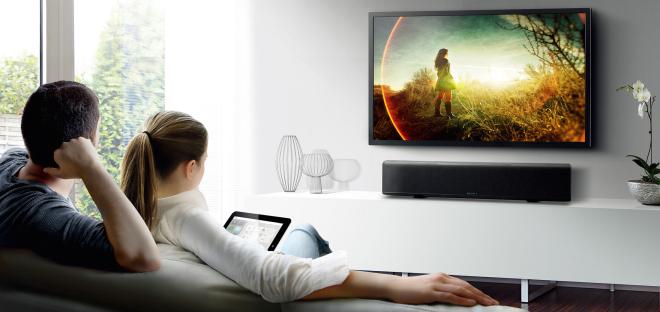
MEET THE YAMAHA YSP-5600
The world's first Dolby Atmos and DTS:X capable sound bar, boasting a 7.1.2 configuration from a single cabinet.
Inside, there's a 32-speaker array for the seven channel surround experience, two six-speaker arrays for height channels, and two woofers. The driver-arrays are made of up what Yamaha calls IntelliBeams, which are small speakers (1-1/2" speakers for the front and surround channels, 1-1/8" for the heights) capable of changing the angle in which they fire based on measurements taken in your living room. Front channel sounds beam directly at your listening position, while surround and height channels bounce off walls and ceilings as needed to trick your ears into believing you have a full 7.1.2 system. LFE comes from an (optional) subwoofer.

In addition to Dolby Atmos and DTS:X decoding, the YSP-5600 also includes Dolby Surround and DTS:Neural:X up-mixing as well as Yamaha's proprietary CinemaDSP sound processing software for turning all of your content into an Atmos-esque experience.
The YSP-5600 also features four HDMI inputs (one with HDCP 2.2 for 4K Ultra HD passthrough), along with three digital and two analog audio inputs, Wi-Fi for internet music streaming and firmware upgrades, Bluetooth for streaming to and from a multitude of smart devices, and Yamaha MusicCast whole home audio compatibility.
In other words, the YSP-5600 is a 46-speaker audio-visual media hub masquerading as a sound bar.
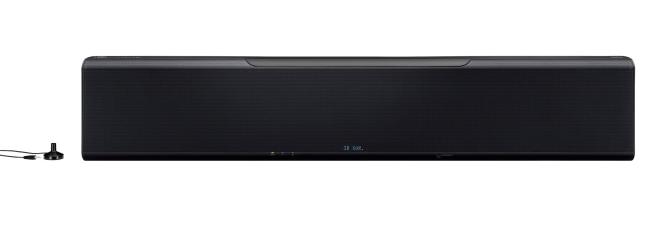
DESIGN & BUILD
The Yamaha YSP-5600 is sleek and elegant. Perfect for wall mounting with a thing-bezel display. Also taller than many sound bars.
Inputs are tucked around back, while the front is faced with black metal speaker grille, a few buttons on top, indicator lights on the bottom, and a tiny bottom-center display that guides you through certain settings or reveals the current audio codec. The rest is finished in flat, black plastic that feels cheaper than Yamaha's AVRs and studio speakers.
Overall, though, it's a handsome unit that, at 43-1/4” x 8-1/2” x 4-3/4” with the included stands, feels almost portable at 25.8 lbs.

SETUP
Sound bars are inherently for people in need of simplicity. In turn, the Yamaha YSP-5600 has the easiest setup I've ever done. The first step is speaker location; the manual suggests several options, but the key is to pick a room where sounds can bounce easily, and to place the 5600 equidistant from the side walls to account for the geometry. I placed my review unit on a TV stand, but the YSP-5600 can be wall-mounted with the optional Yamaha SPM-K30 wall mount kit.
No subwoofer is included, and Yamaha does sell the SWK-W16 wireless transmitter for use with the NS-SW300 Yamaha sub if you want to stay in-brand, but the YSP-5600 plays well with third party gear as well; I used an eight-year-old KEF PSW2500 sub with no problems. Yamaha recommends setting Phase to zero, sub volume to 50%, and the Crossover to the sub's maximum setting (this helps fill in the lower mid-range).
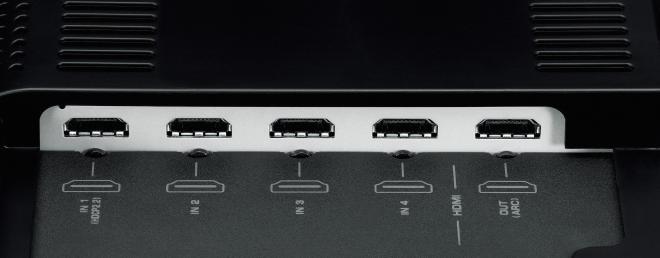
Sound bar is placed and sub connected, plug in your HDMI sources, connect to a display, and follow the instructions. Connect to your network via LAN or Wi-Fi. Update the firmware (as I write this, make sure you have 3.00 or newer to take advantage of DTS:X). And plug in the IntelliBeam microphone to let the YSP-5600 do its thing. Firmware updates take about 10 minutes, but room calibration was super quick and more accurate than other calibrators I've used that take 15-20 minutes worth of measurements.
Now you're ready to go, but if you need to adjust the settings, simply tap the remotes Setup Menu button once for Beam, Sound, HDMI, Display, and Information adjustments, and twice for Network and Bluetooth settings. You can also play around with CinemaDSP processing; otherwise the sound bar defaults to Dolby Surround. Firmware updates will be indicated by an envelop icon that pops up on screen when they become available.

USABILITY: LIVING WITH THE YSP-5600
Outside of having to manually power down my review unit after a successful firmware update, I experience no problems with the YSP-5600. Yeah, the menu could be cleaner and more modern (sometimes it appeared on screen almost too small to read; other times it was larger), but the menu and sub-menues are well laid out and easy to navigate. And, though it plays quite nicely with universal remotes like the Logitech Harmony Elite (review forthcoming), the included remote is ergonomic and well organized. I especially appreciated the separate subwoofer volume adjustment.
For the most part, however, the YSP-5600 disappears, especially when paired via HDMI ARC, which can be activated in the HDMI sub-menu, to the VIZIO P-Series Ultra HD Home Theater Display. Simply tap an app to begin Casting and the P-Series powers the 5600 and seconds later you can be enjoying Ultra HD content with full Dolby Atmos sound. HDMI inputs work equally well, whether it be 4K Ultra HD Blu-ray content passing through without any error codes, or a myriad of DVRs and game consoles and media streamers.
If a next-gen model had a slightly cleaner interface, it would only make an already solid product better.

7.1.2 DOLBY ATMOS & DTS:X & CINEMA DSP
No wires to run... No holes to drill... Just a solitary sound bar capable of decoding and up-mixing all of your content into a 7.1.2 experience... leading us all to one all-important question:
Does it work?
For the most part, yes. But there is one large caveat.
If you're coming from a theatrical or home theatre with in-ceiling or surround speakers, it's instantly clear that the YSP-5600 can't compete in terms of surround precision. Especially in imperfect environments like my living room, the sensation of rear-surrounds is almost non-existent; even in a better room, as was the case with my demo at The Formosa Group Santa Monica, rear surround placement was minimal.
In that sense, I would personally argue that the YSP-5600 produces a terrific sound experience more akin to 5.1.2. With expectations shifted slightly, I trotted out my favorite Dolby Atmos and DTS:X mixes from VUDU UHD, Blu-ray, and Ultra HD Blu-ray. In Atmos, my reference is 'Mad Max: Fury Road' or 'Gravity', while 'Independence Day' sets the bar for DTS:X. I was also able to test out the new 'Batman v Superman: Dawn of Justice' Atmos mix, a dense and punishing soundtrack during the larger set-pieces that will really show off, for better or worse, the dynamic range of your speakers.

In each of these mixes, the YSP-5600 delivers a believably-immersive surround experience. Dialog is pin point and dead center, unless you choose to "lift" it into the height channels. The front soundstage is ultra wide, given the feeling of being in a movie theatre. Side surrounds are strong with a good sensation of objects passing from front to back. Lastly, and perhaps most importantly for Dolby Atmos and DTS:X, overhead immersion is quite good and matches my experience with up-firing speakers from the KEF R50, Klipsch Reference Premiere, and Pioneer Elite Dolby Atmos speakers. In other words, the YSP-5600 places sound objects convincingly overhead to the point where I, a person with actual in-ceiling speakers, feel compelled to check that they are not, in fact, engaged.
Like everything else, you can easily adjust many different "beam" parameters, including volume, distance, and angles; I found surrounds needed a little extra volume and my heights needed a slightly angle adjustment so the felt more directly overhead (rather than more in front). Aside from those tweaks, the surround experience is quite good for a solitary sound bar.

Outside of Atmos and X decoding, the YSP-5600 also offers up-mixing post processing in the form of Yamaha's CinemaDSP, Dolby Surround, and DTS:Neural:X (FYI, DTS:Nueral:X needs to be enabled in the Sound sub-menu). CinemaDSP's 3D surround is a nice feature and plays well with all sound codecs. When CinemaDSP is off, much like the Denon AVR-X6200W, Dolby Surround seems to play only with Dolby codecs, and DTS:Nueral:X only with DTS -- if there was a way to switch between them, I couldn't find it. Yamaha clearly wants people to use CinemaDSP. Overall up-mixing results were good across a variety of codecs and content, but less effective than native mixes.
In terms of sound fidelity, the YSP-5600 definitely needs a subwoofer partner. Mid-to-high frequencies are solid, but there is absolutely no sense of depth of grunt. Given the size of the beams and woofers, this isn't surprising. With a sub engaged, the system really comes alive, producing a fuller and wider dynamic range. That said, for late night listening, having the ability to turn the subwoofer off, or lower its volume independently on the YSP's remote, is helpful.
Honestly, I'm really impressed with the YSP-5600. Sure, it can't compete with a literal nine-speaker surround experience, but it really does deliver a believable Dolby Atmos and DTS:X experience. In a perfect world, I would hope Yamaha would take what they built with this product, include a sub with the purchase, and add in a pair of wireless surround speakers. That would be a showstopper.
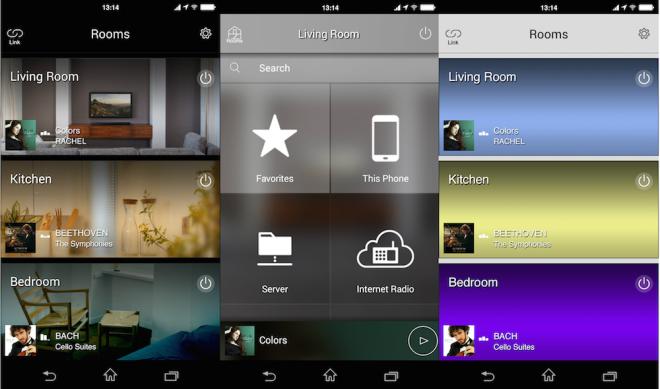
MUSICCAST & BLUETOOTH AUDIO
We covered MusicCast in depth when it was launched last August -- click HERE -- but it's a simple, easy-to-use way to stream music to one, two, or every room in your house courtesy of a free app and all sorts of Yamaha AV Receivers, sound bars, and wireless speakers. Bluetooth integration also allows individual audio sources (like a sound bar or AVR) to OUTPUT music to any brand of Bluetooth speaker.
MusicCast is terrific. While I've yet been able to load up on multiple Yamaha products at the same time, I enjoy showing off its functionality to people who normally avoid tech. As it did in my intro demo and on the terrific Yamaha AVENTAGE A1050, MusicCast works effortlessly. However, if you prefer, there's always normal Bluetooth, Apple Airplay, and DLNA options for streaming music.
Much like movies and television, music sounds pretty good on the sound bar, but any type of rock, rap, or hip hop requires added LFE power from a dedicated subwoofer. Overall, though, I found music sounded clean and clear, and adding CinemaDSP's music settings to the equation all produced pleasing results.
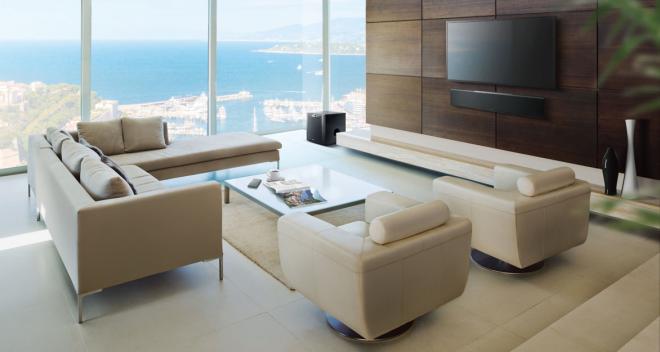
FINAL THOUGHTS
The Yamaha YSP-5600 is a premium sound bar -- the world's first capable of decoding both Dolby Atmos and DTS:X. While it can't compete with a true multi-speaker 7.1.2 Atmos configuration, particularly in reproducing rear surrounds, it does an admirable job. Overhead sound, in particular, is dead on. My other question is one of cost; $1600 is a princely price for a speaker that doesn't include, but desperately needs, a subwoofer.
That said, overall performance factor -- especially if you add a sub -- makes the YSP-5600 perfect for those who need simple but refuse to sacrifice quality. Perhaps you just want to hang and TV and a sound bar in your living room and call it a day. Or maybe you've already got a dedicated home theatre and need a secondary system in a bedroom or den. Recommended.












